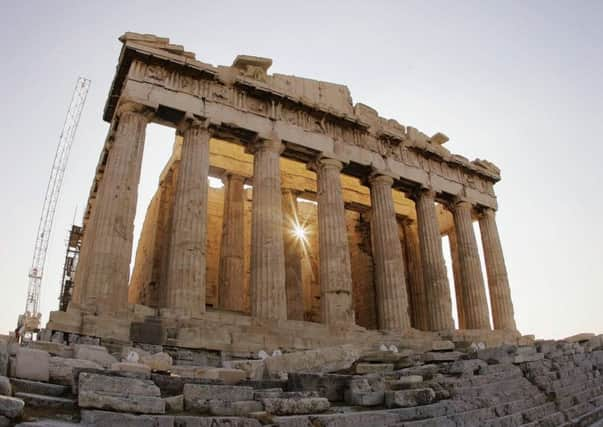Tiffany Jenkins: Parthenon marbles should stay


When the ambitious building programme, ordered by the Athenian general Pericles, commenced on the Acropolis in 447BC, the sculptor Phidias, who directed the work on the Parthenon building, could never had imagined the ensuring fractious debate between Greece and Britain over its sculptures. Or that they would be the subject of an off-the-cuff incendiary remark from a Hollywood movie star 25 centuries later.
George Clooney is promoting his new film Monuments Men, which is about returning art taken by the Nazis. When asked the inevitable question about the Parthenon Marbles in the British Museum in London, the actor replied: “Even in England the polling is in favour of returning the marbles from the Pantheon, the Pantheon marbles.” Returning the parts is, “probably the right thing to do”.
Advertisement
Hide AdAdvertisement
Hide AdHe’s not the first international celebrity to lament the taking of the marbles. Here’s how Lord Byron, who grew up in Aberdeenshire, put it at the time of their removal: “Dull is the eye that will not weep to see
“Thy walls defaced, thy mouldering shrines removed
“By British hands, which it had best behoved”.
It’s understandable that people should sympathise with the Greeks having their marbles ripped off by the British, but it’s not quite as simple as that. It’s not as easy as it sounds to fix them back on what is left of the Acropolis complex in Athens, from where they were taken in 1801 by another Scot, Thomas Bruce, seventh earl of Elgin and 11th earl of Kincardine.
They could go to the Acropolis Museum in Athens, near the original location, which has most of the other sculptures from the Parthenon. When it opened in 2009, the Greek president Karolos Papoulias restated a claim for the return of the pieces in the British Museum:
“Today the whole world can see the most important sculptures of the Parthenon assembled, but some are missing,” he said. “Tragic fate has forced them apart but their creators meant them to be together”.
Sending the Parthenon Marbles in the British Museum to the Acropolis Museum would benefit it and its audiences, but there are good reasons to keep them where they are now, and where have been for more than 200 years – as the centrepiece of one of the greatest collections in the world.
In Greece, visitors can see one set of marbles near their original location, where this set-up helps the visitor to imagine ancient Athens.
In London, you see them in the context of multiple cultures and world history, which helps us understand their significance. Walking through the different galleries of the British Museum you can see how the civilisations of Egypt and Assyria as well as Persia – the enemy of ancient Athens – contributed to the great accomplishment of 5th BC Athens. In turn, by looking at the similarities and differences between the artefacts from different cultures in the galleries, it becomes evident how this Greek art influenced sculpture from Turkey to India. It is also obvious, here, just how great an impact the Greek culture had on the Roman Empire.
Some protest that the circumstances of acquisition are questionable, but Lord Elgin neither looted nor stole the sculptures. The Parthenon in the early 19th century was a ruin. Locals were using blocks from it for their own purposes. Travellers and antiquarians took the pieces that they could carry. Elgin took more than others; he shipped back around 200 tonnes of sculpture, but he also had a letter of agreement – a firman – from the Ottomans who ran the area. Elgin’s agents probably took more than they were meant to, and from the building rather than the floor, but the acquisition was all above board, even if it seems a bit dodgy now.
Advertisement
Hide AdAdvertisement
Hide AdThere are plenty of other cases when dubious actions benefited museums. Take, for example, the National Museums Scotland and its collection of Benin Bronzes.
Benin, the centre of a medieval African kingdom founded in the tenth century in what is now Southern Nigeria, flourished between the 14th and 17th centuries. The Benin Bronzes – magnificent dark red copper alloy sculptures and plaques – were made in this period.
As the British Empire expanded in the late 19th century and was involved in carving up Africa, a bloody battle broke out when the Benin king was considered obstructive in trading negotiations. The sculptures and plaques were taken from Benin by the British army as troops razed it to the ground.
Medical officer Felix Roth described how as they broke into the king’s palace: “beautiful idols were found. All of them were caked over with human blood, and by giving them a slight tap, crusts of blood would, as it were, fly off”. They were taken to pay for the expenses accrued by the army.
It’s a dirty story. One of many. These pasts are important to understand, but trying to arrange collections around what we feel about this history today would be a mistake. It would not just empty museums of their art and artefacts, it would distort our understanding of the past by interpreting it through contemporary mores. Besides, where would such actions end? History is long and messy. The ancient Athenians were not angels. They were warriors. The Parthenon was a display of their power. Slaves helped to build it. Should amends be made?
The role of museums is to further understanding of past civilisations and their accomplishments. Their present situation, where half of the Parthenon sculptures are in Athens and half are in London achieves this. These objects were never made for a museum, nor were they made to be broken up, but even so, divided up into two museums they benefit millions.
The “tragic fate” Papoulias refers to is overstated. Things are good as they are. Clooney should stick to his day job.